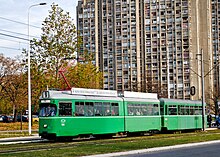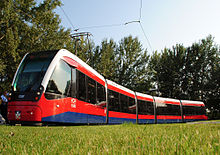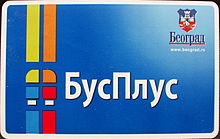GSP Beograd
| GSP Belgrade (GSP) | |
|---|---|
| legal form | GmbH |
| founding | October 14, 1892 |
| Seat | Belgrade |
| Number of employees | 7000 |
| Branch | Public transport |
| Website | gsp.rs |
GSP Beograd ( Serbian Градско саобраћајно предузеће Београд Gradsko saobraćajno preduzeće Beograd , translated: City Transport Company Belgrade ) is the local public transport company of the Serbian capital Belgrade . The GSP serves 112 bus, 12 tram and 8 trolleybus routes . The Beovoz S-Bahn- like system, also operated in Belgrade by the Serbian Railways, is not part of the GSP, but is to be integrated into the tariff system in the future.
History of the GSP
The establishment of the GSP dates back to October 14, 1892 with the first horse-drawn tram between Slavija and Terazije . The horse-drawn tram was known as Beogradska varoška železnica (Београдска варошка железница, German : Belgrader Stadtbahn ). The first bus line followed in 1925 and trolleybuses operated from 1947. Since 1974, plans for a subway have been drawn up under the leadership of the Belgrade Metro project group set up by the city of Belgrade . After a politically motivated distance from the Metro project in the meantime, this is a priority of traffic planning in the GSP with the further development of the urban railway.
The Beovoz S-Bahn, which has been in service since 1984 and has been operated by the Serbian Railways since 2001, is planned for integration into the GSP Belgrade in the city's current traffic development plan from 2008. In the strategy paper, the integration of the Beovoz into the GSP system with a stimulation of the number of passengers also through a shortening of the journey and better connections to the surrounding area is linked with the hope of significantly improving the urban ecological parameters negatively influenced by road traffic. For the further overall reorganization of local public transport in Belgrade, the strategy paper in particular prescribes improved local transport connections in the Beovoz corridor in the future.
In 2009, the city will therefore invest independently for the first time in the Beovoz system, which has been financed by the republic, and has made available 13 million euros from the city budget for its modernization in 2009.
Network area
Today the GSP serves Beograd in conjunction with private bus transport companies via an integrated tariff system, Belgrade and the surrounding suburban communities.
Means of transport
tram
The history of the tram in Belgrade dates back to 1892. In this year a meter-gauge horse tram was opened. Construction of an electric tram began just two years later. By 1905, the last horse tram was also switched to electrical operation.
Expansion stagnated until the end of the First World War . In the interwar period, however, the expansion progressed steadily. From 1928 the bus was added as a competitor . By 1935, the city of Zemun north of the Save was connected to the network.
The Second World War brought with it numerous destruction, including the tram. A number of vehicles were damaged and many tracks were impassable. Among other things, the bridge over the Save was destroyed, so that the line to Zemun became an island operation. This route was never connected to the network again. After the war, construction was slow.

Also, after the war there was initially no planned acquisition policy for vehicle material. No standardization could be seen in the vehicles, which made the maintenance of the vehicle fleet unnecessarily difficult. It was not until the 1980s that vehicles from the Czechoslovak manufacturer ČKD Tatra began to be given a uniform appearance.
No network expansions were carried out until 1985. In that year a connection was re-established via the Sava and Novi Beograd was connected. The network had thus reached an expansion of 42 kilometers and was completely double-tracked.
After the break-up of Yugoslavia and the subsequent isolation of the country, the trams also began to decline. A lack of money and material meant that the route network and numerous vehicles could not be maintained. In some cases, operations were even completely shut down when it rained. In the meantime, numerous used vehicles from Basel are in operation in the city, so that regular services are often running more smoothly again.
In 2011, the introduction of the new tram from the Spanish manufacturer CAF began . By the end of 2012, 30 vehicles of the Urbos 3 tram models are to be purchased in a first batch .
There are currently twelve tram lines:
- Line 2 (ring line): train station - Vukov spomenik - Trg Slavija - train station
- Line 3: Kneževac - Rakovica - train station - Tašmajdan
- Line 5: Kalemegdan - Ustanička
- Line 6: Tašmajdan - Ustanička
- Line 7: Blok 45 - Novi Beograd - Train Station - Tašmajdan - Ustanička
- Line 7L: Blok 45 - Novi Beograd - Train station - Tašmajdan
- Line 9: Blok 45 - Novi Beograd - Railway Station - Banjica
- Line 10: Kalemegdan - Banjica
- Line 11: Blok 45 - Novi Beograd - Kalemegdan
- Line 12: Banovo Brdo - Railway Station - Trg Slavija - Omladinski Stadium
- Line 13: Banovo Brdo - Railway Station - Kalemegdan
- Line 14: Banjica - Ustanička
trolleybus
The GSP operates seven trolleybus routes:
- Line 19: Kalemegdan - Trg Slavija - Konjarnik
- Line 21: Kalemegdan - Učiteljsko naselje
- Line 22: Kalemegdan - Trg Slavija - Kruševačka
- Line 28: Studentski trg - Zvezdara
- Line 29: Kalemegdan - Trg Slavija - Medaković III
- Line 40: Zvezdara - Banjica II
- Line 41: Studentski trg - Banjica II
omnibus
GSP Beograd operates around 100 bus routes.
Subway
→ Main article: Belgrade Metro
There have been plans to build a subway in Belgrade since the mid-1970s . Since then, several versions have been presented, but none of them have reached the implementation phase to this day. At the end of 2008, a new attempt was made to build, based on the plans from the mid-1980s. In the meantime, the priority of subway construction is also being negotiated internationally at the highest political level and several countries have offered their expertise and have expressed financial interest.
Tariff system
Most of the means of transport that are under the control of GSP-Beograd have a uniform tariff system . Electronic tickets have been introduced in public transport vehicles in Belgrade since 2012 . These BusPlus cards represent a new contact-free chip card system with which individual trips can be paid for in advance and also topped up.
Since the BusPlus card is anonymous, the user does not have to register anywhere or show their ID when purchasing. It can be purchased at the service counters at the stops and at kiosks. There are also "personalized" BusPlus cards.
The card can be used in almost all transport systems in Belgrade (with the exception of taxis and Beovoz).
The city's total tariff zone is divided into two tariff zone systems. The integrated tariff zone system 1 (ITS1) covers the inner-city area with two tariff zones. The integrated tariff zone system 2 (ITS2) covers the surrounding area served by LASTA buses over three tariff zones. Monthly tickets can be obtained as job tickets, student tickets, pensioner tickets and disabled tickets.
Two tariff zone systems have also been set up for calculating the fare in Beovoz, which does not fall within the area of responsibility of GSP-Beograd and is operated exclusively by Železnice Srbije, for the actual urban area and the total tariff zone. Around the central zone 1, which is bounded to a large extent by the urban districts of the narrower urban area, there is another zone that includes the outer districts.
In October 2008 the price of single tickets in Beovoz was 25 dinars, in January 2009 32 dinars, in October 2011 50 dinars for a single journey in the inner zone and 90 dinars for the journey through the inner and outer zones. All journeys through both zones cost 90 dinars, regardless of the length of the journey.
Web links
- GSP homepage (also in English) with tram route map (in Cyrillic script)
- BusPlus website
- Pictures of the Belgrade tram
Individual evidence
- ↑ Official website of the GSP Belgrade ( Memento of the original from June 21, 2009 in the Internet Archive ) Info: The archive link was inserted automatically and has not yet been checked. Please check the original and archive link according to the instructions and then remove this notice.
- ↑ City of Belgrade Development Strategy GOALS, CONCEPT AND STRATEGIC PRIORITIES OF SUSTAINABLE DEVELOPMENT, p. 163 (pdf; 3.8 MB) ( Memento of the original dated December 29, 2009 in the Internet Archive ) Info: The archive link was inserted automatically and not yet checked. Please check the original and archive link according to the instructions and then remove this notice.
- ↑ City of Belgrade Development Strategy GOALS, CONCEPT AND STRATEGIC PRIORITIES OF SUSTAINABLE DEVELOPMENT ( Memento of the original dated December 29, 2009 in the Internet Archive ) Info: The archive link was inserted automatically and has not yet been checked. Please check the original and archive link according to the instructions and then remove this notice. (PDF; 3.8 MB)
- ↑ Transport and communications development concept, 45 ff. ( Memento of the original dated December 29, 2009 in the Internet Archive ) Info: The archive link was inserted automatically and has not yet been checked. Please check the original and archive link according to the instructions and then remove this notice. (PDF; 3.8 MB)
- ↑ http://www.beograd.rs/cms/view.php?id=201637 Urban Transport (City of Belgrade - Official Website)
- ↑ https://www.youtube.com/watch?v=QVRXQ_hN6uQ&feature=player_embedded The TV station B92 about the new tram (sr)
- ↑ Metro depending realnost Večernje Novosti December 12, 2008
- ↑ Archived copy ( Memento of the original from June 26, 2012 in the Internet Archive ) Info: The archive link was automatically inserted and not yet checked. Please check the original and archive link according to the instructions and then remove this notice.







